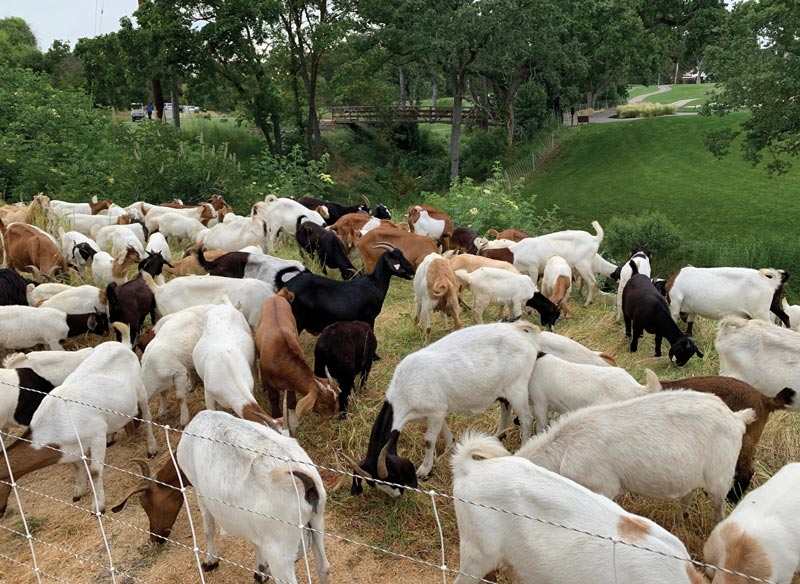
A herd of voracious goats gets to work on a “barranca” at Contra Costa Country Club in Pleasant Hill, Calif., which has employed the hoofed beasts since 2017 as an environmentally (and member-) friendly way to tame the course’s treacherous hillsides. Photos by Ryan Maher
Ryan Maher isn’t the first to unleash a herd of hungry ungulates on a golf course.
Legend has it that several centuries ago, sheep — seeking to avoid the howling wind — huddled in depressions on the Old Course at St. Andrews and thus begat the bunkers. Sheep were the original grounds crew, and woolly mowers still roam courses from the United Kingdom to New Zealand.
Slightly more recently than the Old Course bunker hunkering, a handful of courses — particularly on the West Coast — have learned it behooves them to bring in a different kind of ruminant: goats.
Maher, GCSAA Class A superintendent at Contra Costa Country Club in Pleasant Hill, Calif., and a seven-year member of GCSAA, has procured the services of hundreds of goats the past three seasons to help tame the club’s overgrown “barrancas” — inaccessible and potentially dangerous rocky canyons and hillsides that are common in Northern California.
Beloved from the start by the Contra Costa members, the goats are going big-time — virtually, at least. A video tweet of Maher’s showing the 500-strong goat gang relocating across a mile of the course garnered more than 70,000 views in little over a month.
Maher tweeted this scene of goats on the move at 18-hole Contra Costa Country Club in May 2019:
“I’ve been getting a bunch of questions, some from other superintendents,” Maher says. “I think it’s going to become more of a common thing. Labor is so expensive, and because of restrictions and the emphasis on environmental safety ... no one wants to spray a bunch of pesticides. This is a good visual for neighbors and members. (The goats) are taking care of it in a totally natural, organic way.”
Maher didn’t exactly introduce the idea to the West Coast. He landed at Contra Costa CC in 2015 and was vexed by the steep barrancas, which he says were overgrown with blackberry bushes, thistles and other weeds.
“They’re really dangerous areas for our guys to get in there and weed-eat,” Maher says, “and it was taking us forever to do in-house. It was taking away from jobs on the golf course.”
He had seen goats working on hillsides in the area and learned that Pasatiempo Golf Club in nearby Santa Cruz had been importing itinerant landscaping goats since 2010. In 2017, the goats made their Contra Costa debut, and they’ve been an annual rite of spring since.
“Our members love it,” Maher says. “I’ve had zero negative feedback. It’s really quite a spectacle. In fact, the most common question I get is not, ‘Why are the greens so slow?’ or anything about the course. It’s, ‘When are the goats coming out?’”
Maher, predictably, outsources his four-legged workforce. He pays the folks at Rent A Goat $1,000 per acre, and the Rent A Goat herders handle the rest. The goat guests arrive in modified horse trailers and stick around a week or so. They stay in a temporary enclosure of electrified fencing. A Rent A Goat “shepherd” lives on-site in a trailer in a maintenance yard, along with a border collie to help ride herd.

According to Rent A Goat — the company that furnishes Contra Costa’s grazing crew — goats dine on numerous wild and invasive plants, including poison ivy, thistle and kudzu.
Down the road in Oakland, Calif., at Claremont Country Club, Josh Clevenger has similar goat stories. He, too, saw them working the Northern California land — “I thought, that’s a damn good idea for a way to maintain these natural hillsides,” Clevenger recalls — and back in 2017, he rented his own herd. His goal: Make the concept cost-effective and environmentally beneficial, and allow himself flexibility in directing his strained labor resources.
“Goats checked all of those boxes,” says Clevenger, a GCSAA Class A superintendent and 17-year association member. “It’s really a win-win for everybody. It’s been an absolute home run for us.”
Workforce concerns were what initially drove Clevenger to dip his toe into the goat labor pool.
“A few years ago, we started to have issues with getting to a fully staffed number,” he says. “It seems each year we have fewer people. I was looking at ways to address that and still keep guys focused on tees, greens and fairways.”
The environmental benefits — potential reductions in pesticides and fossil fuels — were just a bonus, albeit a big one.
“Roundup is a big topic. The use of chemicals is a big topic, especially where we live,” Clevenger says. “Now I have people bringing their kids, taking pictures with the goats. And the talk turns from, ‘Look at the golf course as a big polluter,’ to, ‘Look what they’re doing to be environmentally friendly.’
“We’re very much thinking about what’s right for the environment. From every angle, this is a PR win for all. It’s my members’ favorite time of year. I’d say there’s no downside. There’s no better way to maintain natural areas than to graze it.”
Andrew Hartsock is GCM’s managing editor.